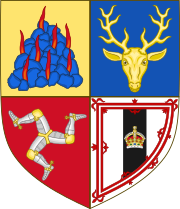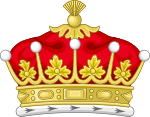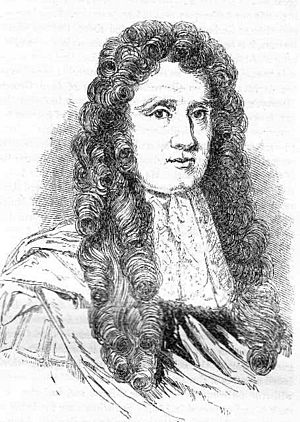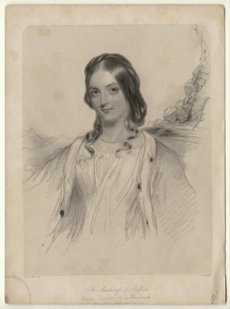Earl of Cromartie facts for kids
Quick facts for kids Earldom of Cromartie |
|
|---|---|

Earl of Cromartie Coat of Arms.
Quarterly: 1st, Or a Mountain Azure in flames proper (Macleod of Lewis);2nd, Azure a Buck's Head cabossed Or (Mackenzie);3rd, Gules three Legs of a Man armed proper conjoined in the centre at the upper part of two of the thighs flexed in triangle garnished and spurred Or (Isle of Man);4th, Argent on a Pale Sable an Imperial Crown proper all within a Double Tressure flory counterflory Gules (Erskine of Innerteall) |
|
| Creation date | 21 October 1861 |
| Creation | Second |
| Monarch | Queen Victoria |
| Peerage | Peerage of the United Kingdom |
| First holder | Anne Sutherland-Leveson-Gower, Duchess of Sutherland |
| Present holder | John Mackenzie, 5th Earl of Cromartie |
| Heir apparent | Colin Mackenzie, Viscount Tarbat |
| Remainder to | By special remainder (see below) |
| Subsidiary titles | Viscount Tarbat Baron Castlehaven Baron MacLeod |
| Status | Extant |
| Seat(s) | Castle Leod |
| Motto | Luceo Non Uro ("I shine but do not burn") |
The Earl of Cromartie (pronounced CROM-ar-tee) is a special title that has been created twice. Both times, it was given to members of the Mackenzie family.
The title was first created in 1703 for Sir George Mackenzie. This was part of the Peerage of Scotland, which is a system of noble titles in Scotland. However, his titles were taken away after he supported a rebellion in 1745.
The title was created again in 1861. This time, it was part of the Peerage of the United Kingdom, which covers noble titles for all of Great Britain and Ireland. The title was given to Anne Sutherland-Leveson-Gower. Since 1979, the Earl of Cromartie has also been the chief of the Clan Mackenzie, a famous Scottish clan.
Contents
History of the Earls of Cromartie
The First Earls (1703-1746)
The first Earl of Cromartie came from the Mackenzie family. His ancestor, Sir Roderick Mackenzie, had a brother who became Lord Mackenzie of Kintail.
Sir Roderick's son, John Mackenzie, received a special title in 1628 called a Baronet. This title was "of Tarbat" in Ross-shire. A baronet title can be passed down through the family.
John Mackenzie's son, Sir George Mackenzie, became the 2nd Baronet. He was a very important politician and judge. He held high government jobs like Lord Justice General and Secretary of State.
In 1685, he was given more noble titles: Lord MacLeod and Castlehaven and Viscount of Tarbat. Then, in 1703, he received the highest honor when he was made Earl of Cromarty.
When the first Earl died, his oldest son became the second Earl. After him, his oldest surviving son became the third Earl.
The 1745 Rebellion
The third Earl of Cromartie supported the Jacobite rising of 1745. This was a rebellion against the king. He led about 400 men from the Mackenzie clan in a battle in 1746.
Lord Cromartie was captured by the government that same year. He admitted he had committed a serious crime against the king. He was sentenced to death, but he was pardoned in 1748. However, he had to give up all his land and titles.
His oldest son, John Mackenzie, also fought in the rebellion. He was also found guilty but received a full pardon. He later had a successful career in both the British and Swedish armies. He even became a Count in Sweden. In 1784, the family's lands were given back to him by an Act of Parliament. John Mackenzie died without children in 1789.
The Mackenzie lands then went to his cousin Kenneth, and later to Lady Isabella Mackenzie. She was the oldest daughter of the third Earl who had lost his titles. Her daughter, Maria Murray, married Edward Hay. Edward added "Mackenzie" to his name as required by the family's will. Their son, John Hay-Mackenzie, passed the lands to his only child, Anne Hay-Mackenzie. She married George, Marquess of Stafford, who later became the Duke of Sutherland.
The Second Creation (1861-Present)
In 1861, the old titles were brought back for Anne Hay-Mackenzie. She became the Baroness MacLeod, Baroness Castlehaven, Viscountess Tarbat, and Countess of Cromartie. These titles were created for her in her own right.
The Cromartie titles were created with a special rule called a "special remainder." This rule meant that if Anne didn't have sons, her daughters could inherit the titles. This was important because her other children were already in line to inherit titles from her husband's family, the Duke of Sutherland. The special remainder helped keep the Cromartie titles separate.
Anne was succeeded by her second son, Lord Francis. He became the second Earl. Lord Francis did not have any sons. When he died in 1893, the titles became "abeyant." This means they were put on hold because there was no clear heir.
In 1895, the titles were given to his elder daughter, Sibell Lilian. She became the third Countess. She married Edward Walter Blunt, who later added "Mackenzie" to his name.
Sibell was succeeded by her oldest son, who became the fourth Earl. He was a soldier and fought in the Second World War, where he was a prisoner of war. In 1979, he was recognized as the chief of the Clan Mackenzie.
Since 1989, his only son, John Mackenzie, has held the titles as the fifth Earl.
The family's main home is Castle Leod, which is near Dingwall in Ross-shire, Scotland.
Mackenzie Baronets, of Tarbat (1628)
- Sir John Mackenzie, 1st Baronet (died 1654)
- Sir George Mackenzie, 2nd Baronet (1630–1714) (became Earl of Cromartie in 1703)
Earls of Cromartie (First Creation, 1703)
- George Mackenzie, 1st Earl of Cromartie (1630–1714)
- John Mackenzie, 2nd Earl of Cromartie (about 1656–1731)
- George Mackenzie, 3rd Earl of Cromartie (about 1703–1766) (titles lost in 1746)
Earls of Cromartie (Second Creation, 1861)
- Anne Sutherland-Leveson-Gower, Duchess of Sutherland, 1st Countess of Cromartie (1828–1892)
- Francis Mackenzie, 2nd Earl of Cromartie (1852–1893) (titles put on hold in 1893)
- Sibell Lilian Blunt-Mackenzie, 3rd Countess of Cromartie (1878–1962) (titles restored in 1895)
- Roderick Grant Francis Mackenzie, 4th Earl of Cromartie (1904–1989)
- John Ruaridh Grant Mackenzie, 5th Earl of Cromartie (born 1948)
The person who will inherit the title next is the current Earl's son, Colin Ruaridh Mackenzie, Viscount Tarbat (born 1987).
See also




